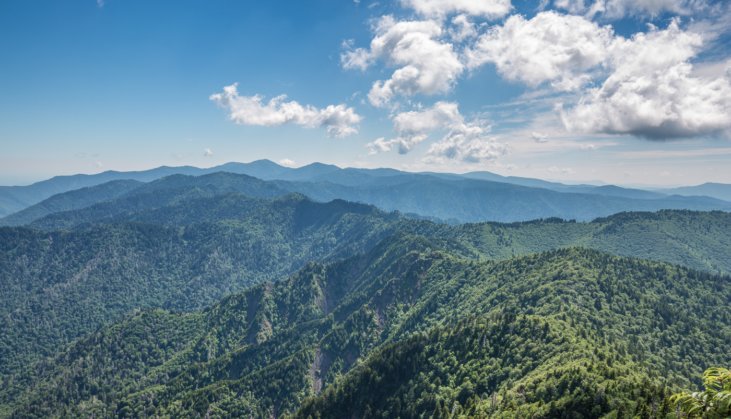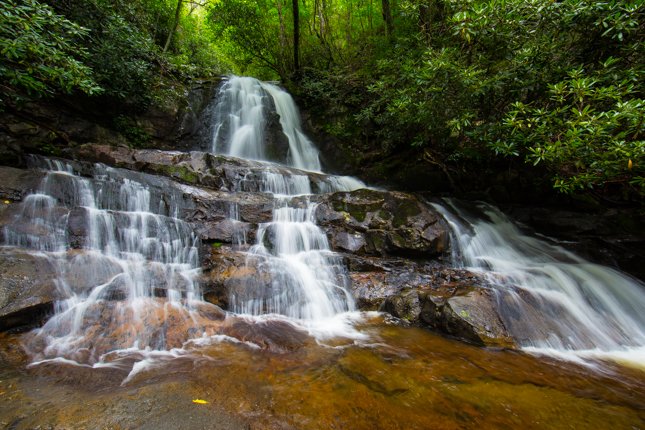Visitors to Great Smoky Mountains National Park experience firsthand one of the most extraordinary places in North America. Some of the tallest, most rugged, and wildest mountains in the eastern U.S define the landscape; they come cloaked in one of the richest examples of temperate forest anywhere in the world. Wildlife abounds, from a tremendous diversity of salamanders and birdlife to such hulking critters as black bears and elk. And fascinating human history and culture, including indigenous Cherokee and a long tradition of Euro-American mountain homesteading, come woven into the package.
Great Smoky Mountains National Park is also the most visited in the country, with north of 11 million parkgoers taking in its magic each year. The preciousness of this mountainscape and the sheer magnitude of its yearly visitors means it’s important to minimize your impact on the environment. Following the “Leave No Trace” approach, as it’s called, makes you a more responsible park visitor: one who lightens his or her footprint on the Smoky Mountain ecosystem and also improves the park experience for everybody else.
Now, while Leave No Trace education is often targeted at backcountry users, the principles also apply to “front-country” campers and day visitors to Great Smoky Mountains National Park. The more folks who follow these basic practices, the more likely it is that this Southern Appalachian wonderland remains beautiful, awe-inspiring, and biologically rich for generations and generations to come.
A Little Leave No Trace Background
Traveling (and living) lightly on the land have been part of human behavior for a long, long time, of course, but the modern concept of Leave No Trace from the standpoint of outdoor recreation stems from advocacy in the 1960s by the U.S. Forest Service.
This soon blossomed into a Forest Service collaboration with the National Park Service, the Bureau of Land Management, and the National Outdoor Leadership School, urging users of public lands to minimize their impacts on the landscape and the ecosystem: not only for ecological reasons but also to ensure the full, continued enjoyment of these places—which are owned by all Americans—by all visitors.
The non-profit Leave No Trace Center for Outdoor Ethics has been educating outdoor users on the concepts of this important code since 1994. Its seven principles of Leave No Trace are as follows:
- Plan Ahead & Prepare
- Travel & Camp on Durable Surfaces
- Dispose of Waste Properly
- Leave What You Find
- Minimize Campfire Impacts
- Respect Wildlife
- Be Considerate of Other Visitors
Practicing Leave No Trace in Great Smoky Mountains National Park

Many of the fundamentals of Leave No Trace are also straight-up rules in a national park such as the Great Smoky Mountains. But because too many park visitors violate those rules—and because not all of the Leave No Trace approach is necessarily captured in specific regulations—it’s worth running through some basics.
Speaking of park rules, let’s emphasize off the bat that following all of them (which you most definitely should) goes hand in hand with a Leave No Trace mentality. The Park Service’s mandates in the Great Smoky Mountains are about protecting the park’s natural resources as well as its human visitors. It’s not easy managing public lands that receive the level of visitation Great Smoky Mountains National Park does; the rules and restrictions are there to make sure the things that draw people from all around the world to the Great Smokies are preserved for the long haul.
Those “things” include not only specific, tangible sights but all the different national-park experiences, including the ability to explore ecosystems dominated mainly by wild Nature, not humankind, and the opportunity to enjoy some sense of solitude.
Don’t Trash the Park
Whether you’re visiting Great Smoky Mountains National Park for just a few hours—checking out Cades Cove, say, or Clingmans Dome—or you’re here for weeks, clean up after yourself. Don’t litter: Use designated waste receptacles for your garbage, or—if you’re backpacking—pack out your trash. Whether it’s a scenic overlook, a picnic site, or a backcountry campsite, leave the places you use in the park without visible evidence of your presence beyond your footprints.
And hey, if you want to earn some Good Samaritan points, consider picking up any litter that you find. Day hikers and backpackers might think about bringing along an extra bag or two to dispose of trash they might notice along the trail in addition to anything they’re generating.
Step Lightly
In general, stay on designated park trails. Much of the Great Smoky Mountains backcountry is technically open to off-trail travel—something only experienced cross-country hikers (firmly adhering by Leave No Trace principles) should attempt—but most visitors will be sticking to established roads and trails, and that in itself helps protect this wildland.
When hiking an unpaved trail in groups, walk single-file to preserve the narrow tread. Don’t take shortcuts or switchbacks to save time, even if you see where others have done so; these “user paths” damage vegetation and soil and can cause severe erosion. Keep on the main path.
If you’re backpacking, don’t follow the same route when accessing areas for washing dishes or digging catholes—you don’t want to beat down a path.
Don’t Deface or Extract From the Landscape
We hope it goes without saying, but don’t deface natural features in the park: No carving your initials into a tree or an outcrop! And it’s both against the law and against Leave No Trace principles to take rocks, wildflowers, or other natural objects here.
Campfires
If you’re camping in the park, avoid burning food scraps or trash; the odors may attract black bears and other wildlife, which may cause problems not only for you but also future users of your campsite.
You may only bring into the park firewood that’s USDA- or state-certified, heat-treated wood: an attempt to limit the spread of insect pests, which have done a lot of damage here and elsewhere in the Southern Appalachians. Backpackers should only collect dead and downed wood to fuel their fires—never cut live green wood or branches from standing dead trees or shrubs.
Respect Those Smoky Mountain Critters
Seeing wildlife is a highlight of many a trip to Great Smoky Mountains National Park: a pileated woodpecker flashing through the backwoods, a hellbender salamander crawling along a streambed, a band of whitetails grazing in Cades Cove, maybe even a mother black bear and her two or three fuzzy cubs. Because wildlife in the park, especially the front-country, is habituated to people, it’s common for animals to go about their daily business without paying much regard to visitors. That can encourage unthoughtful parkgoers to push the limits of safe and responsible wildlife-viewing.
Don’t approach animals too close; this often unnerves them, forces them to expend precious energy, and may provoke defensive behavior. You may want to move in for a better picture, but that’s not worth risking your own safety—or causing wildlife undue stress. It’s illegal to intentionally approach a black bear within 50 yards/150 feet, or to harass any park critters.
Leave No Trace in the Backcountry
All the above applies to backcountry visitors in Great Smoky Mountains National Park, and we’ll quickly summarize some of the additional Leave No Trace practices backpackers and stock users should be following.
Keep your group size small in the backcountry; larger parties not only cause greater physical and ecological impact, but also heighten the chances your noise and presence will degrade the experience of other backcountry users.
You may only camp in designated sites or shelters in the park, and you can only have fires in established fire rings. Besides packing out your trash, you need to properly dispose of human waste: either digging a cathole at least six inches deep that’s 100 feet or more from campsites, water sources, trails, roads, and park structures, or packing it out as well.
Wash dishes a good distance from any water source; while biodegradable soap is better than the alternative, you might also consider not using soap at all—just hot water and enthusiastic scrubbing. Use the onsite bear cable systems to hang your food and any other odor-producing items.
A Final Leave No Trace Thought for Great Smoky Mountains National Park Visits
In a park, as heavily visited as the Great Smoky Mountains, it’s often a good idea to choose some less-popular, less-used destinations to help spread out the human impact—and, just as importantly, enhance your own enjoyment of the park. Ask a ranger to suggest more off-the-beaten-path hiking trails, picnic areas, and scenic drives, and enjoy the extra elbow room!




